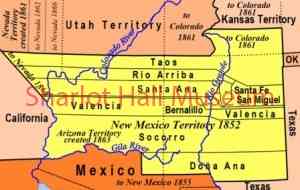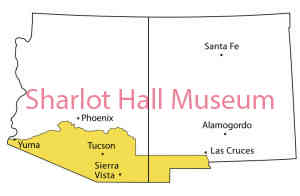By Dave Lewis
Last week we concluded that Arizona did not figure prominently in the Mexican-American War, but Army units crossing Arizona led to some lasting results.
A safe and practical wagon road from New Mexico to California was highly desirable, as it might lead to a good southern route for a railroad. In 1846, the Mormon Battalion became the first party to cross Arizona by wagon, albeit by a circuitous route. Colonel Philip Cooke, commanding, was effusive about this accomplishment:
“History may be searched in vain for an equal march of infantry. Half of it has been through a wilderness where nothing but savages and wild beasts are found, or deserts where, for want of water, there is no living creature. There, with almost hopeless labor, we have dug deep wells, which the future traveler will enjoy. . . With crowbar and pick and axe in hand, we have . . . hewed a passage through a chasm of living rock more narrow than our wagons. . . Thus, marching half naked and half fed. . . we have discovered and made a road of great value to our country.”
 The battalion briefly raised the American flag over Tucson. There was a slight problem, however. When the Treaty of Guadalupe Hidalgo was adopted in 1848 to formally end the war, the southern boundary of Arizona was the Gila River. Tucson and a substantial portion of the battalion’s road remained in Mexico.
The battalion briefly raised the American flag over Tucson. There was a slight problem, however. When the Treaty of Guadalupe Hidalgo was adopted in 1848 to formally end the war, the southern boundary of Arizona was the Gila River. Tucson and a substantial portion of the battalion’s road remained in Mexico.
This scarcely mattered, though, when gold was discovered in California. Countless hopeful prospectors and settlers streamed west along the Mormons’ road.
As of 1848, the land that is now Arizona -- the portion north of the Gila River, at least -- became a part of the United States. It took another two years for the area to be incorporated into an official U. S. Territory -- the Territory of New Mexico. Even then, there were no Mexican or American settlements. If Prescott had existed at that time, it would have been in Valencia County, New Mexico Territory.
It didn’t take long for the government in Washington to realize the mistake in setting the international boundary too far north. Prospectors crossing Mexican territory enroute to California were one thing; planning for a railway was quite another. Negotiations with Mexico soon began with the goal of peaceful acquisition of land below the Gila.
 President Franklin Pierce named James Gadsden a special ambassador to present several proposals to Mexican President Santa Anna. In one extraordinary proposal, Gadsden offered to purchase the headwaters of the Gulf of California and the whole of Baja California (Arizona could have had a seaport). Santa Anna rejected this and other proposals, finally settling on one that created the present-day U.S. - Mexico boundary. The Gadsden Purchase became official in1854, adding nearly 30,000 square miles to the United States (most of it to Arizona) at a cost of $10 million.
President Franklin Pierce named James Gadsden a special ambassador to present several proposals to Mexican President Santa Anna. In one extraordinary proposal, Gadsden offered to purchase the headwaters of the Gulf of California and the whole of Baja California (Arizona could have had a seaport). Santa Anna rejected this and other proposals, finally settling on one that created the present-day U.S. - Mexico boundary. The Gadsden Purchase became official in1854, adding nearly 30,000 square miles to the United States (most of it to Arizona) at a cost of $10 million.
Such transactions are always controversial in Washington. Some derided the new acquisition as “our national cactus garden,” little imagining that a large part of it would someday become the spectacularly beautiful Saguaro National Park.
The old Spanish/Mexican towns of Tubac and Tucson also became part of the U.S. Army posts at Fort Defiance, just north of today’s Window Rock, and Fort Mojave on the Colorado added to the very slow development in this portion of New Mexico Territory -- all nominally governed from Santa Fe.
“Nominally governed” is probably an overstatement. Residents of Tubac and Tucson, almost as soon as they became American citizens, began to chafe at the rule (or general lack thereof) from Santa Fe. Gradually, in the mid-1850s they began referring to their homeland by a new name: “Arizona.” In an 1859 editorial in The Weekly Arizonan, published in Tubac, editor Edward Cross captured the mood simmering since the Gadsden Purchase:
“The territory we have selected for our home is unlike any other portion of the United States. Separated on the one hand by the broad, unsettled wastes of Texas and New Mexico from the Atlantic States, and on the other from the golden sands of California, it resembles neither region in its climate, soil or resources. Attached . . . as we are to the Territory of New Mexico, and situated many hundred miles from its seat of government . . . Arizona is a region without the shadow of anything that claims to be law. The highest crimes may be committed and justice never overtake the fugitive. So far as we know, no judge or justice, Federal or Territorial, has ever visited this portion of the country.”
When our series continues we will discuss additional Army explorations and the origin of the name “Arizona.”
“Days Past” is a collaborative project of the Sharlot Hall Museum and the Prescott Corral of Westerners International (www.prescottcorral.org). This and other Days Past articles are also available at https://sharlothallmuseum.org/articles/days-past-articles.l. The public is encouraged to submit proposed articles and inquiries to dayspast@sharlothallmuseum.org. Please contact SHM Library & Archives reference desk at 928-445-3122 Ext. 2, or via email at archivesrequest@sharlothallmuseum.org for information or assistance with photo requests.


